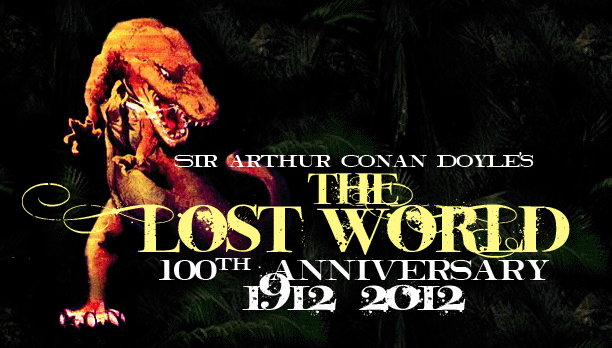

|
In 1998, The Lost World received the honor of being inducted into the United States Library of Congress’ National Film Registry. Administered by the private National Film Preservation Board advisory committee, the National Film Registry is dedicated to recognizing and preserving culturally significant American films.
Made by John R. Bray in 1926, The Lost Whirl was a short parody of The Lost World. The story itself featured a gentleman and his lady being accosted by dinosaurs in a barren and rocky landscape, culminating in a battle between a Brontosaur and T-rex, with the straw hut the people were hiding in being cast off a cliff. The dinosaurs themselves were a combination of stop motion for long shots and living lizard faces for close ups. A comedic short from beginning to end, even the dinosaur battle was slapstick, and the t-rex is perhaps most notable for how he tip-toes through the scenes. This wasn't Bray's first rip-off either. In 1915, he created his own version of "Gertie" to capitalize on Winsor McCay's Gertie the Dinosaur cartoon. Another tantalizing possibility is a 1926 film by Luis Seel entitled Finding the Lost World. Reported to be a comedic short mixing live actors and animation, the date and title suggest another parody of The Lost World, though it can’t be known for sure. Ironically, Finding the Lost World is a lost film.
In the September 1927 edition of The English Journal, teacher M. Gude of New Jersey reports using The Lost World to help along a group of young, remedial English students: "Soon after school opened the science class visited the Natural History Museum and 'wrote up' their trip for a science lesson. I offered to help them with the papers, one of which was interesting enough to be published in the school paper. As I read the various accounts of the trip I noticed that everyone had been vastly intrigued by the 'dinisores' and 'brontisores.' The next day I asked how many had seen 'The Lost World' in the movies. After we had talked about the various creatures of the Reptile Age I told them I had the book frmo which the movie was taken. One boy read the book - and liked it; a waiting line was formed - and I think everyone read the story. Next I introduced them to Langsford's First American Animals. They seemed to like that as well as The Lost World, though no one, during the whole year, won them as completely as Conan Doyle."
In 1925, The Lost World, its brontosaurus and Wallace Beery left and indelible mark in the psyche of a 12-year old Robert Clampett, who more frequently went by the nickname of Bob. After working for a time making Bugs Bunny cartoons with Warner Brothers, Bob Clampett went into his own in 1949. In his televised mix of puppeteering and animation, Beery’s Challenger provided the inspiration for one of the characters, named Captain Horatio K. Huffenpuff and later shortened to Unca Captain. The climactic scene of the brontosaurus falling into the Thames and swimming back to South America provided the inspiration for a sea-sick sea serpent named Cecil. Cecil, of course, would be teamed with a young boy named Beany to create one of cartoon history’s most beloved duos.
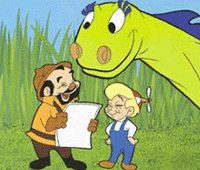
Palaeontology, evolution and natural history was also highlighted in the media of 1925 by way of the infamous Scopes "Monkey" Trial. In its aftermath, defense attorney Clarence Darrow would be tapped by Samuel Cummins of the educational film making firm Classic Productions to co-narrate a feature film documentary about evolution with Prof. H.M. Parshley. Released in 1931, Mystery of Life used clips from The Lost World.
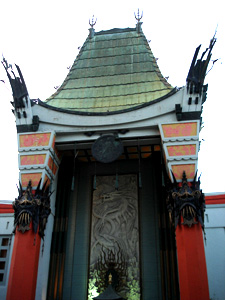
|
After such a gripping success in the theatres, time would prove to be The Lost World's enemy. The prints would pass around from hand to hand, with each stop whittling away just a bit more of the finished product.
In the wake of Warner Brothers' 1929 purchase of First National Pictures, the film suffered its first and most lasting indignity by being cut from an hour and a half to an even hour. The original, full-length version was withdrawn from distribution (that this was also the dawn of sound pictures may also have had something to do with it) and the shortened, hour-long version was sub-licensed to Kodascope Libraries. Formed by the Kodak Company in the same year as the film’s release, Kodascope specialized in 5 to 20 minute short films or 45 to 60 minute edits of feature films for the university and home viewing markets.
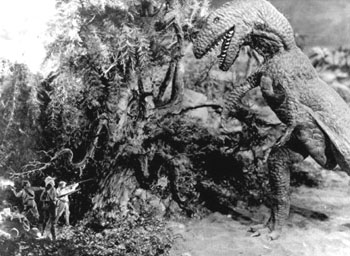
Promotional still photo. Anticipating the interests of Kodascope's market, this shortened version cut the introductory sequence between Gladys and Malone (which provides Malone’s impetus as well as the romantic tension later between Malone and Paula White), Challenger’s meeting up with the expedition in South America, and several small cuts from the climactic scenes in London. Perhaps it had a lot to do with the complaints of critics over the fussy love elements that partly provoked them to cut those and other dramatic elements in favour of the dinosaurs. In 1948, Encyclopedia Britannica purchased the film and made further cuts, reducing the hour-long version to a 5 minute short intended for English classrooms. Retitled A Lost World, As Told By A. Conan Doyle, this short begins in the drawing rooms of 1912 London with an actor portraying Sir Arthur Conan Doyle. For the interest of his fellow pipe-smoking gentlemen of leisure, Conan Doyle tells the “true” story of Roxton’s expedition up the Amazon, where they accidentally stumble onto the plateau where Willis O’Brien’s stop-motion footage still lives. After a harrowing day of nature red in tooth and claw, the expedition escapes the volcanically explosive mountain via rope ladder and a well-placed cavern in the cliff face. The Lost World languished in its Kodascope version for decades until, thankfully, renewed interest in dinosaurs and dinosaur films in the 1990's resulted in some spectacular new finds. In the mean time, the clearest restoration of the shortened version was released by Lumivision Laserdisk in 1991 (later transferred to DVD in 1999), using several prints from the non-profit film and photo archives of George Eastman House. This release included the trailer and the commercial for the Bob Sherms puzzle found in the UCLA film archives, and a library of still photos. However, also in 1991, the stock footage company Petrified Films purchased a collection of prints from Warner Brothers that included eight minutes of outtakes from The Lost World. This was accompanied in 1992 by the unprecedented discovery of a nearly complete print of the full film in the Filmovy Archiv of the Czech Republic. Additional footage was uncovered in a pair of private collections and in the Library of Congress. These new materials from around the world were collected by George Eastman House, who restored the film under the guidance of Ed Stratmann. With a price tag of over $80,000 US, a serious fundraising effort was spearheaded by the Dinosaur Interplanetary Gazette website. Among the 50 donors were Milestone Video and Campfire Video, the National Endowment for the Arts, 18 anonymous readers of the Dinosaur Interplanetary Gazette, filmmaker Joe Dante and Playboy kingpin Hugh Hefner. Controversy would dog this restoration effort and George Eastman House. Early screenings of the restoration in 1997 revealled that Eastman House left all but 20 seconds of the 8 minutes of outtake footage out of the film, on the basis that it was not described in Marion Fairfax’s original script. However, many existing scenes are also not listed in the script either, leading to a healthy debate over whether or not the outtake material should be included. But in addition to this, it was also being reported that scenes that previously were in the film had been removed, whether accidentally or on purpose. To these reports, Ed Stratmann replied that the early screenings had been a work-in-progress that allowed his team to see what still needed attention. Following these screenings, Stratmann reported work on reincluding the dropped footage and reworking the new intertitles (many of which had to be translated from Czech) to better match the original. Few were able to check up on Eastman House's work, though, since they refused to release the completed version to home video. By reserving the print for exclusive theatrical showings (which often went unannounced), they turned the Dinosaur Interplanetary Gazette and their doners against them, leading to a letter campaign by the Gazette to see the film pressed on DVD. In response, well-known silent film publisher David Shepard utilized the same materials as George Eastman House to compile and restore his own version of the film that was relased on DVD by Image Entertainment in 2001. In addition to the previously mentioned materials - the Kodascope, the Czech and UCLA archives, and A Lost World - Shepard also made use of a Society of Motion Picture Engineers reel of test footage, a 1927 interview with Sir Arthur Conan Doyle (to stand in for the framing sequence in which Conan Doyle recited his famous poetic introduction to The Lost World novel, the original shooting script, and the printed 1925 score. However, while the version Shepard restored (and often recreated) is the most complete version so far, it still has its faults. Erring on the side of political correctness, he rewrote many of the intertitles to take the accents out of the mouths of Austin and Zambo. Many fans of the film felt these to be unwarranted acts of cultural effacement.
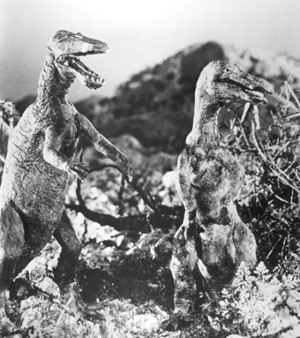
Promotional still photo. However, in September of 2007, the George Eastman House print finally surfaced. Unmoved by the moral cause of the Dinosaur Interplanetary Gazette, Twentieth Century Fox was able to influence them into including their restoration as a bonus disk in the DVD release of the 1960 remake. Of course, for fans of The Lost World, it's the 1960 version that is the "also ran" while the 1925 version takes centre stage. Nevertheless, it arrived only a decade overdue. Unimaginable in the modern world where movies are immediately moved from darkened theatres to store shelves, restoring silent films is an art form that is as vague and interpretive as translating sacred scriptures. There isn't, and cannot ever be, a truly deffinitive version of The Lost World that is exactly as it would have been in 1925. Multiple versions can only give a general impression of the film as each one varies from the other in various ways. Such is the case between the George Eastman House and the David Shepard prints. The advantages of the Eastman House print were that it flowed much more smoothly, using careful editing to avoid the jumpiness and sometimes confusing mess of the Shepard print. Where Shepard worked to include almost every scrap of film possible, sometimes clumsily stringing them together, the Eastman House print slid into these far better. They also retained the original dialogue, unaltered for the sake of political correctness. Unfortunately, though, reports of too-large parts of the finished film being left out were true. A significant portion of the dinosaur sequence in the middle of the film was excised... a portion that appeared not only in the Shepard print, but even in the Kodascope version! A clip where a herd of Triceratops protect their young from a passing Allosaurus had been relegated to the included outake reel, and after that, the scene of the Agathaumus goring the Allosaurus was missing entirely. Furthermore, to pad out scenes, the Eastman House print tended to splice in brief clips from elsewhere in the movie. At the beginning of the film, Malone is seen going up the steps of Challenger's home to enter Gladys'. While climbing the tree to survey Maple White Land, the scene cuts to the Allosaurus perched on the dead Agathaumus, preparing to pounce a Pterodactyl. The same cut replays later during that actual scene. Being so desperate to fill the film out, George Eastman House would have been well-advised to make use of the footage they spliced out to begin with.

Promotional still photo. The clearest indication of the ambiguity of silent film restoration is in the radical difference in dialogue between the two prints in the sections pulled entirely from the Czech source material. Forced to translate whole from Czech and draw from the original shooting script, the scene in Gladys' house and in the Amazonian cabana play out much differently. Additional (or restored) dialogue was also included in the Eastman House print, making some of the prexisting scenes a great deal more sensible. Between the two, the Shepard print included more footage while the George Eastman House print was more artistically accomplished as a film. However, neither one came out perfect... or at least as close to perfect as possible. It is hoped that at some point in the future, another restoration can be made that blends the strengths of each and matches it with the original score and "theme song" to truly recreate The Lost World. Review by Cory Gross.
|